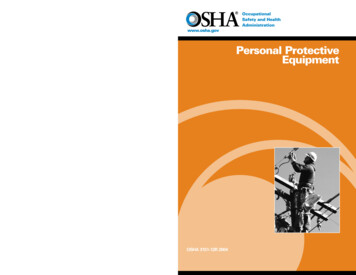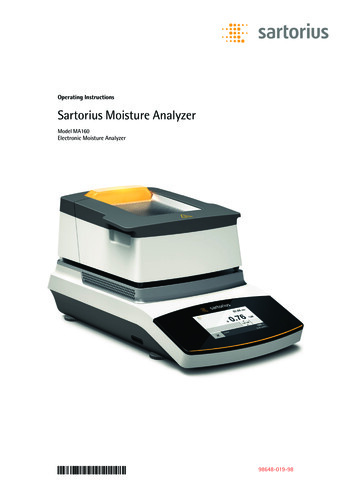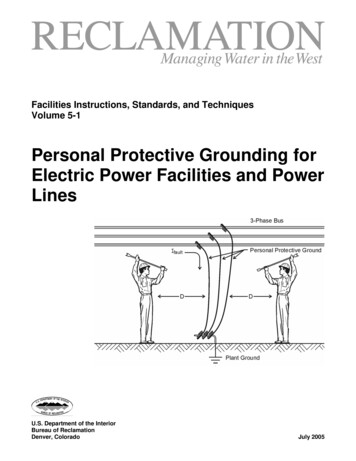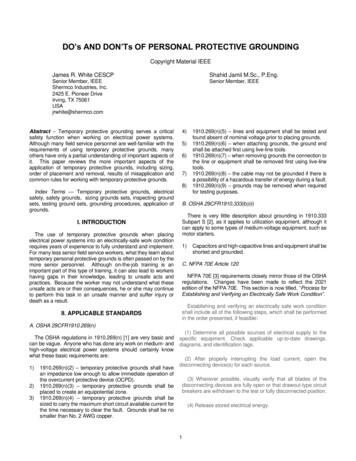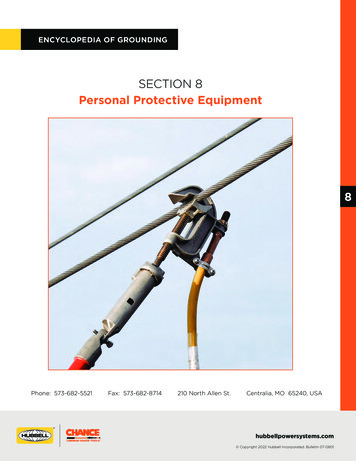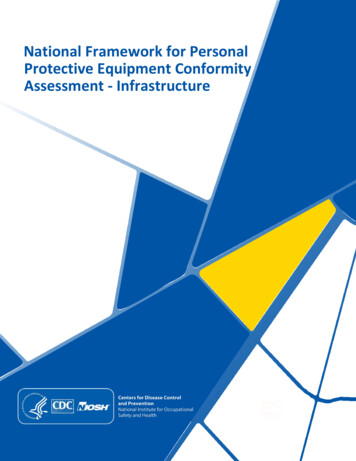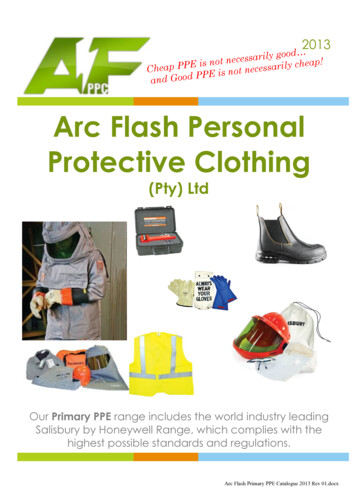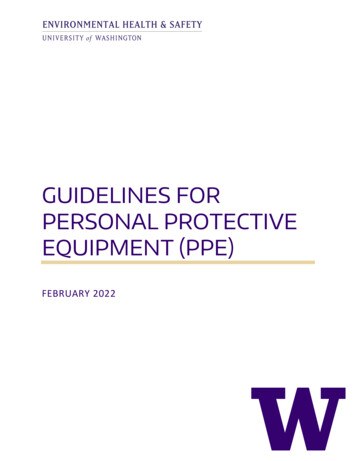
Transcription
GUIDELINES FORPERSONAL PROTECTIVEEQUIPMENT (PPE)FEBRUARY 2022
TABLE OF CONTENTSRequirements . 3Hazard control . 3Supervisor responsibilities. 4How to Use This Guide . 4Step One: Assessment . 5Step Two: PPE Selection . 5Step Three: Training. 5Step Four: Documentation . 5Hazard Control and PPE . 7PPE Selection. 13Safe Use and Removal of PPE . 33Inspection, Maintenance and Storage . 33Sources for PPE. 34Resources . 35Appendix A: Welding Operation Shading Guide . 36Appendix B: Safety Shoes and Prescription Safety Glasses . 37Appendix C: Masks and Respirators – Understanding the Difference . 39This is a guide to fulfill the minimum requirements and doesn’t cover every conceivable hazard. Ifyou need additional assistance in identifying engineering or administrative controls or in selectingPPE for a hazard, contact the EH&S Occupational Safety and Health Office at 206.543.7262.
REQUIREMENTSThe Washington State Department of Labor and Industries (L&I) in WAC 296-800-160 PersonalProtective Equipment (PPE) requires all employers to assess their workplace for hazards that mightrequire the use of personal protective equipment. If PPE has to be used, the supervisor must selectthe proper equipment and require its use.HAZARD CONTROLEliminating hazards through engineering or administrative control measures is the best way toprotect people. The strategy used for the selection of controls is called the “hierarchy of controls”which prioritizes the types of controls that are most effective in eliminating or reducing the risk ofexposure to the hazard.PPE is the least effective method for controlling or preventing exposure to a hazard. PPE providesa barrier to protect the worker from potential exposure to hazards, however due to the relianceon the worker to select, wear and maintain PPE, the likelihood of exposure to the hazard with PPEalone increases.EH&S PPE Guidelines Occupational Safety & Health Revised February 2022 www.ehs.washington.edu Page 3 of 41
In some cases, PPE is required by regulations or internal procedures and can provide an additionalcontrol to help protect the worker. This guide will provide information and tools to assess PPE,manage and understand the limitations of PPE.SUPERVISOR RESPONSIBILITIESEach Supervisor has the responsibility to review all of their employees’ jobs for PPE needs. Theregulations, the degree of hazard, and the engineering or administrative controls that are in placewill determine what PPE is needed. If departments will be using PPE for personnel hazards, thefollowing items must be completed: Assess the workplace for hazardsSelect appropriate PPEEnsure PPE is usedEstablish inspection, maintenance and replacement procedures to make sure damaged PPEis not usedTrain employees in proper use, limitations, care and maintenance of PPEDocument assessment, selection, and trainingIf all of the above mentioned items are documented in existing departmental procedures, such asa laboratory safety manual, departmental Standard Operating Procedures (SOPs) or Job HazardAnalyses (JHAs), for all employee worksites, then no further work is needed.When the hazard assessment indicates that PPE is required, employing departments must providethe PPE to employees free of charge. Exceptions are prescription safety glasses and safety shoes.Where a hazard assessment determines that no PPE is needed, document the assessment and youare done. However, remember that if a hazard exists which does not require PPE, otherregulations or programs may be applicable. Contact EH&S if you have questions or concerns.HOW TO USE THIS GUIDEThis guide is designed to help departments, organizations, and units, and supervisors in the stepsto assess their workplace, select the right equipment, train employees and document this work. Inaddition, EH&S has developed the following “PPE Tools” for laboratories and shops to assistPrinciple Investigators (PIs), laboratory managers and shop supervisors in assessing anddocumenting hazards and appropriate PPE for their specific work areas. Laboratory PPE Hazard Assessment GuideShop PPE Hazard Assessment GuideEH&S PPE Guidelines Occupational Safety & Health Revised February 2022 www.ehs.washington.edu Page 4 of 41
Step One: AssessmentSelect the job, process or procedure you are going to assess. Survey the worksite and identify thehazards the worker will be exposed to while doing the work. Use one of the EH&S PPE HazardAssessment Guides or a worksheet of your own to list the identified hazards. The HAZARDCONTROL AND PPE section below may help determine the hazards.Step Two: PPE SelectionIf PPE must be used, list the PPE that will be used for each hazard identified on your form. Thesupervisor or person completing the assessment and selection must sign and date the form.Step Three: TrainingAfter the assessment and selection, employees required to use PPE must be trained before theyare required to use the PPE. Retraining must be done if PPE requirements change and as needed.All of the following must be covered: What PPE to use and when to use itLimitations of the PPEHow to put it on, take it off and adjust itInspection and maintenanceAny manufacturer instructions and warningsMake sure the PPE fits wellHow to obtain PPEHow to dispose of PPEStep Four: DocumentationThe following information must be retained by University departments to document the PPEhazard assessment, PPE selection and training. Job, process, or activity being assessed Hazards identified Selection of PPE used for each hazard identified. PPE type, brand, model may need to bespecified. Person(s) or job title identified to use PPE Name and title of person completing the hazard assessment Date hazard assessment was completed Name, title, training date for all employees required to wear PPE.Forms are included in the laboratory and shop PPE hazard assessment guides. You may devise yourown method for documenting these actions.Remember: Departments that record this information in existing policies or procedures maycontinue to use their current method and do not need to create new documentation for PPE.EH&S PPE Guidelines Occupational Safety & Health Revised February 2022 www.ehs.washington.edu Page 5 of 41
For example, laboratories write an SOP as part of their Chemical Hygiene Plan. A properly writtenSOP contains all of the needed information along with documentation of the employee training.Back to TopEH&S PPE Guidelines Occupational Safety & Health Revised February 2022 www.ehs.washington.edu Page 6 of 41
HAZARD CONTROL AND PPEThis section provides an overview of exposure controls and PPE that may be needed for a varietyof tasks that have potential hazards. For specific task procedures and recommended controls inlaboratories, consult the Laboratory Safety Manual; for Shops and Maintenance work, consult theUW Facilities employee website.Laboratory workersTask(s)Potential HazardControlsWorking with low hazardchemicals when a low probabilityof splash existsSkin and eye irritationFume hood, localexhaust, good generalventilation, encloseprocessWorking with smaller amounts( 1 liter) of corrosive or injuriouschemicals where a reasonableprobability of splash existsSkin and eye damageWorking with larger quantities ofcorrosive liquids ( 1 liter), ortoxic corrosivesLarge surface area skinand eye damagePoisoning, or greatpotential for eye andskin damageFume hood, localexhaust, good generalventilation, encloseprocess Bench topshieldFume hood, localexhaust, good generalventilation, encloseprocessWorking with small volumes oforganic solvents ( 1 liter)Skin and eye damageSlight poisoningpotential through skinabsorptionFume hood, localexhaust, good generalventilation, encloseprocessWorking with large volumes oforganic solvents ( 1 liter), highlytoxic organic solvents or workwhich may create a splash hazardMajor skin and eyedamagePotential poisoningthrough skin absorptionFume hood, localexhaust, good generalventilation, encloseprocess Bench topshieldWorking with small volumes ofhuman blood, body fluids orother potentially infectiousmaterials (OPIM) as defined inthe UW Bloodborne PathogenExposure Control proceduresPotentially infected withinfectious disease (BBP)Potential spread ofinfectious diseaseBiological safetycabinet (BSC)PPESafety glassesLight chemical resistant glovesLab coat, closed shoes, long pants,long skirt or equivalent leg covering(no shorts)Chemical splash gogglesLight chemical resistant glovesLab coat, closed shoes, long pants,long skirt or equivalent leg covering(no shorts)Chemical splash goggles & faceshieldAppropriate heavy chemicalresistant glovesLab coat, closed shoes, long pants,long skirt or equivalent leg covering(no shorts) and chemical resistantapronSafety glasses, goggles if splashhazard existsLight chemical resistant glovesLab coat, closed shoes, long pants,long skirt or equivalent leg covering(no shorts)Safety goggles & face shieldAppropriate heavy chemicalresistant glovesLab coat, closed shoes, long pants,long skirt or equivalent leg covering(no shorts) and chemical resistantapronSafety glassesDisposable nitrile glovesLab coat, closed shoes, long pants,long skirt or equivalent leg covering(no shorts)EH&S PPE Guidelines Occupational Safety & Health Revised February 2022 www.ehs.washington.edu Page 7 of 41
Laboratory workers (continued)Task(s)Working with large volumes ofhuman blood, body fluids orother potentially infectiousmaterials and/or splash hazardsPotential HazardControlsPPEIncrease potential ofbecoming infected withinfectious disease (BBP)Increased potentialspread of infectiousdiseasePotential skin and eyedamagePotential for poisoningthrough skin absorptionBSCBench top shieldSafety goggles & face shield, nitrilegloves, lab coat, closed shoes, longpants, long skirt or equivalent legcovering (no shorts), coveralls andfoot covers may be necessaryFume hood, goodgeneral ventilation,enclose processWorking with acutely toxichazardous powdersGreat potential skin andeye damageGreat potential forpoisoning through skinabsorptionFume hood, goodgeneral ventilation,enclose processWorking with dispersibleradioactive materialsPotential tissue damagePotential spread ofradioactivecontaminationWorking with radioactivechemicals (corrosives, solvents,toxics, etc.)See appropriatechemical section abovePotential tissue damagePotential spread ofradioactivecontaminationShield the sourceMinimize exposuretimeIncrease distance tosourceFume hood, goodgeneral ventilation,enclose processWorking with radioactive humanblood, body fluids or otherpotentially infectious materialsPotential tissue damagePotential spread ofradioactivecontamination Potentialexposure to OPIMWorking with sealed radioactivesourcesDamaged or leakingsource may spreadcontaminationSome leaking sourcesmay pose an externaldose risk.Safety glasses, goggles for largequantitiesLight chemical resistant glovesLab coat, closed shoes, long pants,long skirt or equivalent leg covering(no shorts)Safety gogglesAppropriate chemical resistantglovesLab coat, closed shoes, long pants,long skirt or equivalent leg covering(no shorts), coveralls and booties ifnecessaryAppropriate eye protectionDisposable nitrile glovesLab coat, closed shoes, long pants,long skirt or equivalent leg covering(no shorts)Safety glasses, goggles for splashhazardLight chemical resistant glovesLab coat, closed shoes, long pants,long skirt or equivalent leg covering(no shorts).Use PPE for applicable tasks above.Safety glasses, goggles for splashhazardDisposable nitrile glovesLab coat, closed shoes, long pants,long skirt or equivalent leg covering(no shorts)Safety glassesLight glovesShield may be needed for highenergy sourceWorking with hazardous powdersBSCShield the sourceMinimize exposuretimeIncrease distance tosourceFume hoodBench top shieldMinimize exposuretimeIncrease distance tosourceEH&S PPE Guidelines Occupational Safety & Health Revised February 2022 www.ehs.washington.edu Page 8 of 41
Laboratory workers (continued)Task(s)Potential HazardControlsWorking with cryogenic liquidsMajor skin, tissue andeye damageGood generalventilationWorking with very cold materialsand equipment (freezers, dry ice)FrostbiteHypothermiaUse tools to handleobjectsWell insulated storagecontainersWorking with hot liquids,equipment and/or open flames(autoclave, Bunsen burner, waterbath, oil bath)Skin damageEye damageExhaust heat, goodgeneral ventilationEquipment guardsWorking with large volumes ofhot, cold, or cryogenic liquidsMajor skin and eyedamageFrozen or burned bodytissuesExcellent generalventilationWell insulated storagecontainersWorking with UltravioletRadiationConjunctivitisCorneal eye damageErythemaGuard source or usebench top shieldWorking with LASER radiationRetinal eye damageSkin damageGuard source or usebench top shieldWorking with Infrared emittingequipment (glass blowing)Cataracts and flashburns to corneaGuard source or usebench top shieldArc/TIG weldingConjunctivitisCorneal eye damageErythemaInstrument or equipmentrepair/serviceMetal working/WoodworkingshopGlassware washingEye damage fromforeign objectsEye damage fromforeign objectsSkin lacerationsLocal exhaustventilation, excellentgeneral ventilationShieldingEquipment guardsLocal exhaustEquipment guardsLocal exhaustDesignated areaAppropriateequipment andsuppliesPPEChemical splash goggle and faceshieldCryogenic insulated glovesLab coat, closed shoes, long pants,long skirt or equivalent leg covering(no shorts)Safety glassesInsulated gloves and warm clothingLab coat, closed shoes, long pants,long skirt or equivalent leg covering(no shorts)Safety glasses or goggles for largevolumes or splash hazardsInsulated glovesLab coat, closed shoes, long pants,long skirt or equivalent leg covering(no shorts)Safety glasses or goggles and faceshieldHeavy insulated glovesLab coat, closed shoes, long pants,long skirt or equivalent leg covering(no shorts), apron or coverallsUV face shield and gogglesLab coat, closed shoes, long pants,long skirt or equivalent leg covering(no shorts)Appropriate shaded goggles withoptical density based on individualbeam parametersLab coat, closed shoes, long pants,long skirt or equivalent leg covering(no shorts)No jewelry/reflective items allowedAppropriate shaded gogglesLab coat, closed shoes, long pants,long skirt or equivalent leg covering(no shorts)Appropriate shaded goggles,welder’s helmet with appropriateeye shade (see Appendix A)Working glovesSafety glassesNo loose clothing or jewelrySafety glassesNo loose clothing or jewelrySafety glassesHeavy rubber glovesLab coat, closed shoes, long pants,long skirt or equivalent leg covering(no shorts)EH&S PPE Guidelines Occupational Safety & Health Revised February 2022 www.ehs.washington.edu Page 9 of 41
Laboratory workers (continued)Task(s)Working in Industrial lab withpotential injury from fallingequipment or tools (ex.Earthquake lab, StructuralEngineering lab, etc.)Shop and Maintenance workersTask(s)Potential HazardHead injury, foot injuryPotential HazardAutomobile/Heavy EquipmentMechanic WorkFlying particles,petroleum solvents andwastesLocksmith WorkFlying particlesWood Working Work (Shop)Noise, flying particles,lifting/carrying, roughsurfaced materialsMetal Working Work (Shop)Noise, flying particles,lifting/carrying, roughsurfaced materials,metal working chemicalsPainting (Shop)Vapors, mists, solventsand chemicals,flammablesHot surfaces, contactwith surfaces (head),noisePower Plant WorkTunnel WorkElevator Maintenance WorkContact (head),restricted access areas,heat stress, hot surfacesUncovered electricalswitches and circuits,falling, movingmachineryControlsEquipment bracing,securements, toollanyardsControlsEquipment guards,shieldingLocal exhaust, goodgeneral ventilationGood housekeepingEquipment guards,shieldingLocal exhaust, goodgeneral ventilationGood housekeepingEquipment guards,shieldingLocal exhaust, goodgeneral ventilationGood housekeepingInsulate, secure noisyequipmentEquipment guards,shieldingLocal exhaust, goodgeneral ventilationGood housekeepingInsulate, secure noisyequipmentLocal exhaust, goodgeneral ventilationGood housekeepingEquipment guards,shieldingLocal exhaust, goodgeneral ventilationInsulate, secure noisyequipmentGood generalventilation, lightingEquipment guards,shieldingLocal exhaust, goodgeneral ventilationHard hatSteel toe shoesPPEPPESafety glasses, chemical resistantglovesSafety glasses, face shield whenusing high speed toolsHearing protection, safety glasses,face shield for high speed tools,puncture/cut resistant gloves,safety shoes, guards in placeHearing protection, safety glasses,face shield for high speed tools,puncture/cut resistant gloves,safety shoes, guards in placeSafety glasses, organic vaporrespirator w/particulate pre-filter,chemical resistant glovesHeat resistant gloves, hard hats,hearing protectionHard hat, light clothing,temperature resistant gloves,safety glassesElectrically insulated gloves (ratedfor energized voltage), fallprotection, cut/puncture resistantglovesEH&S PPE Guidelines Occupational Safety & Health Revised February 2022 www.ehs.washington.edu Page 10 of 41
Shop and Maintenance workers (continued)Task(s)Potential HazardControlsConfined Space WorkHazardous atmosphere,restricted exit, otherdepending on nature ofthe spaceArc Welding or CuttingElectric shock, metalsparks, molten and hotmetal, UV, IR and visiblelight, falling, dropping,rolling and sharp objectsOxy-fuel Welding or CuttingMetal sparks, moltenand hot metal, UV, IRand visible light, falling,dropping, rolling andsharp objectsMetal sparks, moltenand hot metal, UV, IRand visible light, falling,dropping, rolling andsharp objectsLocal exhaustventilation, excellentgeneral ventilationShieldingTorch SolderingMolten and hot metal,UV, IR and visible light,falling, dropping, rollingand sharp objectsLocal exhaustventilation, excellentgeneral ventilationShieldingMetal Grinding or ChippingMetal sparks and chips,falling, dropping, rollingand sharp objectsCarpentry Work (ConstructionSite) Masonry Work(Construction Site) Laborer Work(Construction Site)Flying particles, falling,falling objects,cuts/punctures,lifting/carryingLocal exhaustventilation, excellentgeneral ventilationShieldingEquipment guards,secure objects andtools, guard rails,warning linesPainting Work (Construction Site)Flying particles, falling,falling objects,cuts/puncture,lifting/carrying, cleaningsolventsEquipment guards,secure objects andtools, guard rails,warning linesRoofing WorkFalling, hot surfaces,heat and cold stress,sealing chemicals,solvents, lifting/carryingInstalled roof anchors,guard rails, warninglines, fall protectionplansTorch BrazingWarning signs,restricted entry,permit may berequired per UWConfined Space EntryProgramLocal exhaustventilation, excellentgeneral ventilationShieldingLocal exhaustventilation, excellentgeneral ventilationShieldingPPEDetermine appropriate personalprotective equipment inaccordance with the UW ConfinedSpace Entry ProgramInsulating mats or blankets,insulated/heat and puncture/cutresistant gloves, safety shoes, hardhat, safety glasses, welding shieldor helmet with appropriate eyeshade (see Appendix A).Heat and puncture/cut resistantgloves, safety shoes, hard hat,safety glasses, welding shield orhelmet with appropriate eye shade(see Appendix A)Heat and puncture/cut resistantgloves, safety shoes, hard hat, filerlens spectacles or goggles, or safetyglasses and hand shield, withappropriate eye shade (seeAppendix A).Heat and puncture/cut resistantgloves, flame resistant clothing,safety shoes, hard hat, filter lensspectacles or goggles, or safetyglasses and hand shield, withappropriate eye shade (seeAppendix A).Heat and puncture/cut resistantgloves, typical work clothing, safetyshoes, safety glasses, full face shieldSafety glasses, safety shoes, hardhat, cut/puncture resistant gloves,fall protection when working atelevations. When using high speedpower tools, a face shield.Safety glasses, safety shoes, hardhat, cut/puncture resistant gloves,chemical resistant gloves, fallprotection when working atelevations. When using high speedpower tools, a face shield.Safety glasses, safety shoes, fallprotection, heat resistant gloves,chemical resistant gloves.Temperature stress protectiveclothing, depending on weatherconditions.EH&S PPE Guidelines Occupational Safety & Health Revised February 2022 www.ehs.washington.edu Page 11 of 41
Shop and Maintenance workers (continued)Task(s)Potential HazardControlsSheet Metal Work (ConstructionSite)Flying particles,lifting/carrying, roughsurfaced materialsEquipment guardsLow Voltage ElectrifiedEquipment WorkElectric shock, fallingEquipment guards andinsulation, guard rails,warning lines, fallprotection plansHigh Voltage ElectrifiedEquipment WorkElectric shock, arc,explosion and burns,falling, confined spaces,vehicles in traffic areasEquipment guards andinsulation, guard rails,warning lines, fallprotection plansAir Conditioning/RefrigerationWorkWater treatmentchemicalsGood generalventilationPlumbing WorkHot surfaces, roughsurfaced materials,sewageEye hazard, cuts fromblade, noiseCarpentry WorkOperating wood and metal sawsand other power toolsMoving wood and metal pieces,liftingGeneral Maintenance WorkCustodial WorkFoot hazard, droppingobjects and piercingobjects, wood splinter,pinchRough surfacedmaterials,lifting/carryingCleaning chemicals,splashesRefuse WorkNoise, sharp objects,garbageGrounds Keeping WorkPesticides, noise, flyingparticles, heat stress,insect and plant toxinsEquipment guardsPPESafety glasses, safety shoes,puncture/cut resistant gloves.When using high speed powertools, a face shield.Electrically insulated gloves (ratedfor voltage of energizedequipment), insulated blankets ormats, non-synthetic work clothing,fall protection when working atelevationsHard hat, safety glasses, face shield,insulated gloves (rated for voltageof energized equipment), insulatedblankets or mats, non-syntheticwork clothes, safety shoes, fallprotection when working atelevations, reflective clothing whenworking near trafficChemical resistant gloves, safetyglasses. When using largequantities of chemicals, a faceshield & gogglesHeat resistant gloves, safetyglasses, cut/puncture resistantgloves, rubber glovesSafety glasses with side shields orgoggles, face shield, hearingprotection, guard in placeGloves appropriate for workLeather work shoe/boot with thicksole, glovesCut/puncture resistant gloves,safety glasses, safety shoesGood ventilation andhousekeeping inchemical storageareasGood ventilation andhousekeeping inchemical storageareasChemical resistant gloves, safetyglasses. When pouring largequantities of chemicals, a faceshield & goggles.Hearing protection, safety glasses,cut/puncture resistant gloves,rubber gloves, safety shoesHearing protection, safety glasses,gloves, protection from pesticidesaccording to label, application, andreentry requirements, skinprotection from insects and plants,safety shoes, gloves, respiratoryprotection as neededEH&S PPE Guidelines Occupational Safety & Health Revised February 2022 www.ehs.washington.edu Page 12 of 41
Shop and Maintenance workers (continued)Task(s)Potential HazardControlsPest Management WorkPesticides, animals andplantsGood ventilation andhousekeeping inchemical storageareasTree Trimming workPesticides, falling, noise,flying particles, heatstress, insect and planttoxinsGood ventilation andhousekeeping inchemical storageareasMoving WorkLifting/carryingProvide carts, handtrucksPPESafety glasses, gloves, protectionfrom pesticides according to label,application, and reentryrequirements, skin protection fromanimals and plants, respiratoryprotection as neededFall protection, hearing protection,protection from pesticidesaccording to label, application, andreentry requirements, skinprotection from insects and plants,safety shoes, safety glasses, glovesSafety shoes, glovesPPE SELECTIONPPE selection should be based on a job hazard analysis (JHA), which includes evaluation of hazards,specific tasks, procedures and work practices, in consultation with area supervision and EH&S asneeded. See the EH&S Job Hazard Analysis webpage for more information and link to a templateJHA. This PPE selection guidance is not intended to be a comprehensive resource on PPE.Eye and Face ProtectionHand ProtectionSkin and Body ProtectionRespiratory ProtectionBench Top ShieldsBack to TopHead ProtectionFoot and Leg ProtectionHearing ProtectionFall ProtectionArc Flash Protective Clothingand PPE for Electrical WorkersEH&S PPE Guidelines Occupational Safety & Health Revised February 2022 www.ehs.washington.edu Page 13 of 41
Eye and Face ProtectionSafety glasses, safety goggles, laser eyewear, face shields and helmets provide a level of protectionas designated by the manufacturer. The hazard and the protection standards for each piece of eyeand face protection PPE must be considered during selection.PPESpecific TypeSafety glassesComply withANSI Z87.1Direct ventedGogglesComply withANSI Z87.1Disposablemedicaleye shieldCharacteristicsApplicationsPolycarbonate lens, sideshieldsWorking withchemical, biological,radiation, physicalhazardsAllows the flow of air intothe goggle. Protectionfrom impactWorking withparticulates[Note: Personnel withcorrective lenses will need“over-prescription” safetyglasses or prescription safetyglasses.See Appendix B for procedureto obtain prescription safetyglasses][Tends to fog less,but should not beused with liquid orfine dust hazards]Protection fromparticulates andfrom chemicalsplashIndirect ventedProvides protection fromsplash entry by a hoodedor covered ventNon-ventedProvides protectionagainst the passage ofdust, mist, liquid andvaporsProtection fromparticulates,chemical splash,and mist, liquid andvaporsProvides protection fromsplash, spray, spatter ordroplets of blood or otherpotentially infectiousmaterials.Health care,biological hazards[Not ANSI Z87.1 compliant][Note: Not forprotection fromchemical, physical,and impact hazards]EH&S PPE Guidelines Occupational Safety & Health Revised February 2022 www.ehs.washington.edu Page 14 of 41
(continued)PPELaser eyewearSurgical/proceduremaskFace shieldSpecific TypeCharacteristicsApplicationsAppropriately shadedgoggles; optical densitybased on beamparametersWorking with Class3 or Class 4 lasers,consult laser useauthorization forspecificapplications.Protects nose and mouthfrom direct contact withbiological and chemicalfluids; prevents spread ofaerosolized infectiousbiological agentsAnatomical,surgical, medicaland clinical settings[Note: Mask is not arespirator thatprotects frombreathing anythinginto the lungs.]For use withpotential chemicalsplash orprojectiles,apparatus underpressure or vacuum,cryogenics handlingImpact and chemicalresistant face shield mustbe combined with safetyglasses or gogglesComply withANSI Z87.1Disposablemedical faceshieldProvides protection fromsplash, spray, spatter ordroplets of blood or otherpotentially infectiousmaterialsOptical faceshield[Not ANSI Z87.1 compliant]Face shield with specialoptical density (OD) valuefor ultraviolet radiation(UV) or infrared shieldingHealth care,biological hazards[Note: Not forprotection fromchemical, physical,and impact hazards]Working with UV orinfrared emittingequipmentEH&S PPE Guidelines Occupational Safety & Health Revised February 2022 www.ehs.washington.edu Page 15 of 41
(continued)PPESpecific TypeCharacteristicsApplicationsImpact resistant lenses andavailable in graduatedshades of light filtrationWelding withpotential sparking,scaling, harmfullight raysWelder’shelmetDurable helmet withfiltered lensEnsure proper shadenumber is chosen fordarkness of the lens. SeeAppendix A.Welding to protecteyes and faceagainst heat,speaks, flash burn,ultraviolet orinfrared lightArc-rated faceshieldSpecialized electrical safetyequipment for facialprotectionElectrical safetyapplications withhigher hazard/riskor unknownWelder’sgogglesBack to PPE listEH&S PPE Guidelines Occupational Safety & Health Revised February 2022 www.ehs.washington.edu Page 16 of 41
Hand ProtectionGloves should be selected for each procedure to provide prote
EH&S PPE Guidelines Occupational Safety & Health Revised 6/2020 www.ehs.washington.edu Page 3 of 40 REQUIREMENTS The Washington State Department of Labor and Industries (L&I) in WAC 296‐800‐160 Personal Protective Equipment (PPE) requires all emplo
